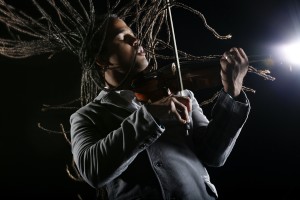
Roumain’s ‘Dreamers’ Proves Accessible, Attractive
Back in late September, violinist and composer Daniel Bernard Roumain premiered his Dancers, Dreamers and Presidents, a three-part tone poem inspired by an impromptu dance that talk-show host Ellen DeGeneres and then-U.S. Sen. Barack Obama did during the 2008 presidential campaign.
The work debuted Sept. 25 at the Lincoln Theatre in Miami Beach, at an early-season concert of the New World Symphony conducted by Alasdair Neale.
Roumain, a son of Haitian immigrants who grew up in Margate and went on to study at Vanderbilt and the University of Michigan, now has a flourishing career as a rare kind of crossover artist who can bring the same kind of compositional rigor to popular and classical styles. That leads to pieces such as Sonata for Violin and Turntables and a violin method featuring Hip-Hop Etudes, as well as two discs of pop music with his backup band, The Mission (the most recent is Woodbox Beats and Balladry).
But it also indicates Roumain’s seriousness of mind and his openness to musical expression of all kinds, and that gives all of his work an unimpeachable sincerity.
I couldn’t make the premiere, but I’ve been able to secure a recording of that first performance, and the music is very much in keeping with all his work: Eclectic, heavily rhythmic, and with a fondness for bluesy motifs that announce themselves insistently.
The first movement of the symphony begins with solo drums and percussion for more than a minute, followed by the two musical elements that will supply the movement’s basic architecture: an urgent, syncopated minor-ninth pattern, heard first in the strings, and a riff-like main theme announced in the upper winds that climbs up to a blue note, then scurries around playfully before descending and then expiring in a slide.
These two elements are repeated by different instrumental groups, then appear in combination at the end, as the volume builds to a brass-heavy conclusion. This is dance music rather than symphonic music with a traditional Germanic orientation, but I say that only as a way of comparison; it’s not music that was designed to roll like Haydn.
The second movement, by contrast, sounds in its first two minutes much like Shostakovich, with somber lines in the basses and celli building slowly out of the depths into a dark landscape. Then the theme of the first movement, and the drum kit, return, driving the music forward while the layers first laid down by the strings continue to rise like giant panels behind the busy chatter of the riffs and drums.
The music is highly dissonant, but it’s the organic, logical dissonance that comes out of lines falling over each other, and it, too, climbs to a huge climax before being wiped away suddenly at its emotional high point.
Third movement starts with a synthesizer playing a sweetly somber minor-key pop-chord progression, setting up a gentle, expectant mood. A bassoon plays an elaborate cadenza-style passage, then the drum kit enters with what Roumain calls an “old-school hip-hop beat.” Strings pick up the chord progression, creating a movie-soundtrack kind of feel, then the orchestra develops a tiny change to the progression first heard in the synthesizer.
The music widens into full-on riffs in the strings, trading places with horns playing a rising pattern derived from the progression change. These steadily rising chords are taken over by the full orchestra to become the main material, and the movement ends in an exultant shout.
Roumain has written music here that would be very effective for the dance, and indeed his resume includes years of work with the noted choreographer Bill T. Jones. It’s attractive, easily understood music, and while it lacks the kind of melodic profile that could make it truly memorable, it represents a successful compromise with commercial and symphonic styles.
It also is recognizably by the same composer as the man who wrote the hip-hop cut Armstrong on Woodbox Beats and Balladry, and if being a renowned composer means you first need to develop a distinctive personal style, then it appears Daniel Roumain is on his way.
Recent Content
-
Artsarticle ·
-
Artsarticle ·
-
Artsarticle ·
